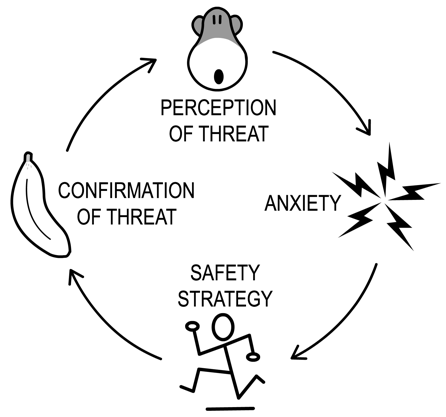Glossary
What is The Monkey Mind?
Monkey Mind: Is a metaphor for the amygdala, and other associated parts of the brain that are dedicated to our survival. Everything we see, touch, hear, taste and smell is screened for threat, much like traveler baggage passing through airport security. When a threat is detected, anxiety is triggered. This part of the brain is primitive, instinctual and reactive, much like a monkey. This analogy allows us to envision anxiety not a monster needing to be conquered, but as the work of a sensitive little critter, loyal, hardworking and devoted to our safety.
Feeding the Monkey
When the limbic brain, or monkey mind detects a threat, it sounds an alarm, which we experience as negative emotion and anxiety. When we respond by performing a safety strategy, we confirm the perception of threat, guaranteeing more alarms in the future. Thus, safety behaviors “feed” the monkey mind, maintaining a cycle of anxiety.

Core Fear
There are two fundamental, or core fears activated by the monkey mind. The first is the fear of death, or conditions that could make life not worth living, such as loss of health or shelter. The death could apply to either the self or loved ones. The second core fear is loss of social status, respect or belonging; being “kicked out of the tribe” and thus alone forever.
Safety Strategies
Safety Strategies serve two purposes.
- They are the things we do to keep the worst from happening. For example, someone with a spider phobia might check their bed before getting into it in an attempt to prevent a spider bite.
- They serve to avoid, resist, or distract ourselves from negative feelings that arise when we feel we are not 100% safe.
5 Step Action Plan for Coping with Anxiety
Step 1. Identify the problem clearly. Instead of saying, Everything could fall apart, you might say, I am worried about losing my health care.
Step 2. Brain storm four different actions you can take. For example:
-
Educate yourself about policies related to health care.
-
Write letters to public officials stating your concern.
-
Volunteer at or donate to an organization that supports healthcare for all.
-
Move to another country. (Remember, you are brainstorming. Each idea does not have to be realistic.)
Step 3. Evaluate each action. Think of the short and long term consequence of each one.
Step 4. Pick one or more of the actions, and act.
Step 5. Look at the results. What are the positive and negative consequences of the actions you took? Are there other actions to take? Pat yourself on the back for doing something!
When we take responsible action, it helps reduce feeling overwhelmed and helpless. The monkey mind gets the message that, I am aware of the threat and I am handling it, and our anxiety is reduced. It does not mean that the problem is solved, but that we are constructively involved in doing something about it.
Responsibility Pie
OVER RESPONSIBILITY
|
Monkey Mindset |
Expansive Mindset |
|
I believe that if someone I care about is not making a good choice, it is my responsibility to do something about it, if I don’t I am partly responsible for the consequence. |
I believe that people are responsible for their own lives and the choices they make. Consequences of their actions are not my fault. |
|
If I set a limit with someone or state a preference, I feel responsible for their feelings. |
When I set a limit or state a preference, I can be sensitive to other’s feelings without taking responsibility for them. |
|
If others do not do their fair share of the work, it is my responsibility to take up the slack. |
If others do not do their fair share of the work, it is not my responsibility to step up. I am willing to allow the consequences of other people’s action or inaction. |
|
I tend to put other people’s needs before my own. |
I believe that taking care of myself is more or as important than taking care of others. |
|
When others are in pain I become upset and try of fix their problem and/or point out what they are doing wrong. |
When people are in pain, I can listen with compassion but it is not my job to fix or solve their problem |
Values List
This list of values can help you determine which values will give your practice purpose and direction.
SELF-ACCEPTANCE
GROWTH
OPEN
CREATIVITY
SPIRITUALITY
FUN/PLEASURE
COMMITMENT
RESILIENCE
ADVENTURE
HEALTH
HONESTY
KINDNESS/CARING
FLEXIBILITY
HUMOR
PRESENCE/MINDFULNESS
COURAGE
AUTONOMY/INDEPENDENCE
TRUST
AUTHENTICITY/GENUINESS
LOVE
RESPONSIBLE
RISK
COMPASSION
TOLERANCE

